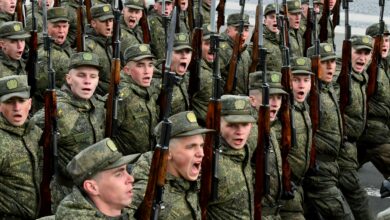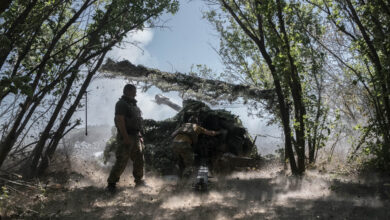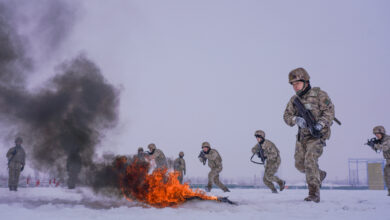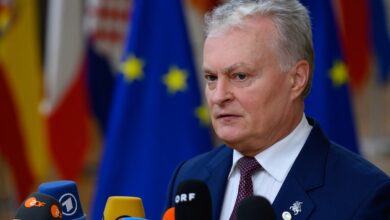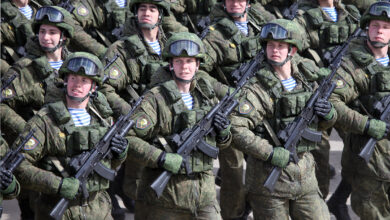
Sixty-three days of sustained bombardment as an underground resistance movement bravely fought off an invasion by a major world power. Motivated by values of liberty, dignity, unity, and resilience, this small Eastern European nation resolved to resist an aggressor much greater than they.
In the end, their centuries-old capital city was demolished to unrecognizable rubble, occupying Russian soldiers marched in, and the country remained under Communist rule for the next 45 years.
No, this isn’t a forecast of Ukraine in 2022.
It was the Warsaw Uprising of 1944, the single largest military effort taken by any European resistance movement in World War II.
It’s a glimpse of not only history repeating itself today, but insight into Slavic die-hard determination to fight against occupation as well as Poland’s current unwavering support to their neighbor — because they once shared the same suffering.
Resolve in Poland
On August 1, 1944, the Polish Home Army and resistance leaders launched an armed insurrection in Warsaw against German control of Poland.
Timed with the anticipated arrival of the allied Soviet Red Army on the city’s outskirts, this military endeavor saw average civilians become fighters, courageously banding together for the survival of their nation.
As the Polish flag waived defiantly from balconies, clerks and factory workers formed barricades of stones, furniture, and overturned vehicles.
Resolve replaced fear as Molotov cocktails were hurled at rolling tanks below bedroom windows. Even children participated by putting out fires, digging graves, and performing reconnaissance missions, while many women fought, cooked, and cared for the wounded.
All flocked to help, convinced they could be liberated from five years of Nazi occupation.
There were scenes of brave mobilization and horrifying repercussions, no different from those today in Kyiv, Lviv, and Kharkiv.

Warsaw Uprising
The Warsaw Uprising intended to liberate Poland from German occupation while helping the Allies beat Germany and legitimize the Polish exiled government in London before a Soviet-backed regime could assume control.
Trapped between its traditional enemies of Germany and Russia, Poland was fighting for a pro-Western capitalist future, while Russia fought for territory. As such, it is not surprising that the anticipated Soviet reinforcements never arrived, allowing for the destruction of any Polish partisan opposition to eventual Soviet control.
A Nazi counteroffensive followed, and, in the end, an estimated 200,000 civilians were killed. By the end of the year, 85 percent of the city lay incinerated in bombarded heaps of debris.
Only two wall fragments remained standing of the 600-year-old Royal Castle, a symbol of Polish statehood and history. One revealed a cartouche with the royal version of the Order of the White Eagle’s motto displayed stating, “Pro Fide, Lege, et Rege” (For Faith, Law, and the Nation).
Collective Consciousness
For this reason, a red and white Polish flag banner hanging today in the Przemyśl train station on the Ukrainian border proclaiming “Jesteś tutaj bezpieczny” (You are safe here) means more than just its words. It conveys, “Brother, you are welcome here. We have endured the same. And we will help you survive.”
There is a collective consciousness defined by the tragedy and heroism of war and the shared struggle of the Slavic people yearning for freedom from Russian oppression that unites these nations.
For this reason, the Polish prime minister traveled to Kyiv, in the middle of bombardments, to express his solidarity while his hands remained tied by more powerful NATO member decisions.
European Integration
This long-forged fighting spirit of relentless resistance and unwavering aspirations of integration with Europe and the West began to show in Ukraine during its Orange Revolution (November 2004 – January 2005) when thousands successfully protested the corrupt election of the pro-Russian Viktor Yanukovych to power.
But Russia still refused to surrender its grasp on the former Soviet territory. A decade later, the Euromaidan clashes in Kyiv would be instrumental in conveying Ukrainian resolve toward full European integration and organizing grassroots military resistance efforts.
Prompted by a pro-Russian government’s refusal to sign a free trade agreement with the EU, the deadly protests saw up to 800,000 Ukrainians demonstrating in the bitter cold, proclaiming, “We are a European nation, and we will fight for our future!”
Now known as the Maidan Revolution or Revolution of Dignity, the movement succeeded in overthrowing the Russian puppet government of President Yanukovych and the destruction of Soviet monuments throughout the country.
But most importantly, it empowered ordinary Ukrainians, no longer fearing Soviet tyranny, to fight to the death for their country’s economic and political transformation.
Fervor for Freedom
It is incomprehensible that any world leader witnessing these momentous Ukrainian revolts would believe this nation would willingly subject itself to Russian occupation today.
The fervor for freedom compensates quality and supply of arms. But in time, exhaustion and dwindling food, shelter, and supplies may demoralize those embroiled in a relentless battle of attrition.
If the country falls to an occupying regime, unrest will rage, insurgent warfare in the streets will continue, and an insurrection will boil below the surface, fueled by an unyielding determination of liberation from a communist regime.

Rising Phoenix
However, as Warsaw (often termed the Phoenix City) rose from the ashes, it showed that a Slavic nation cannot be decimated with its buildings. Immediately after WWII ended, it began rebuilding the capital, the Old City, and even restoring the Royal Castle from voluntary contributions.
Today, Poland stands strong at the forefront of aiding Ukraine in its fight against invasion. Its valiant efforts in becoming the key logistical hub for weapons are with the full understanding that this might make them Russia’s next target.
And as news broadcasts from Kyiv continue to show grandmothers building Molotov cocktails, powerful icons of resistance like President Volodymyr Zelensky remaining in a warzone, tennis stars returning to fight on the front lines, and proclamations of “Slava Ukraini” (Glory to Ukraine) reverberating throughout rallies around the world, the people’s courage and determination is a force to be reckoned with.
It will also be the force that one day rebuilds what has been destroyed, giving rise to yet another Phoenix City.
 Luiza M. Carter is a Polish-American raised in New York City. She is a career public servant with the US Department of Defense.
Luiza M. Carter is a Polish-American raised in New York City. She is a career public servant with the US Department of Defense.
She received an MA in International Security Studies from Columbia University and a BA in Political Science from Pace University after personally witnessing the events of 9/11 in her home in downtown Manhattan.
Disclaimer: The views and opinions expressed in this article are those of the author and do not necessarily reflect the official policy or position of any agency of the US government.
The views and opinions expressed here are those of the author and do not necessarily reflect the editorial position of The Defense Post.
The Defense Post aims to publish a wide range of high-quality opinion and analysis from a diverse array of people – do you want to send us yours? Click here to submit an op-ed.


